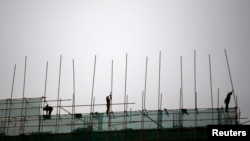Over the past year Chinese officials have embraced lower economic growth forecasts, saying they are winding down the huge government spending that fueled the country’s rapid economic growth in recent decades.
Instead, officials say they are pursuing "higher quality" but more modest growth aimed at boosting domestic consumption and growing the economy in a more well-rounded way. Last week, Chinese Premier Li Keqiang reinforced this view when he announced a seven percent target growth rate in 2015, below the economy’s average performance over the past two decades.
But there are signs that the government has not yet abandoned its big-spending ways.
The premier also announced a 13 percent increase in fixed asset investments while announcing new investments in sectors like energy, railways, water conservancy, drainage and housing.
Some economists feel this spending greatly exceeds what is needed for the government’s seven percent growth target.
"A silent stimulus plan seems to have been unrolled in the form of additional investments," said Shen Jianguang, chief Asia economist at Mizuho Securities Asia in Hong Kong. "The additional investment aims to support the construction industry, which can in turn boost the cement, steel and housing industries."
Big spending to create 10 million jobs
In January, Li Keqiang pledged to create 10 million new jobs in 2015, partly through new investments in construction-related sectors.
In 2008, China worked to counter a possible financial crisis by announcing an enormous stimulus package worth $570 billion. In comparison, this year Li has specifically allocated $260 billion for railways and water conservancy while designating several other sectors for financial stimulus.
But the big investments in infrastructure largely do not address China’s perennial problem of how to boost domestic consumption and create more demand for goods and services.
This week, Tao Ran, an economist and professor at Renmin University, told the state-run broadcaster CCTV that consumption levels are much less than what is required to ensure steady growth in the Chinese economy. Consumption by the general public is estimated at just about 40 percent of the economy while government agencies make up the bulk of the rest.
Stimulus means more debt spending
To pay for these new projects, authorities are borrowing more money.
Finance Minister Lou Jiwei said at a news conference that deficit spending will be around 2.7 percent of GDP. This is a notable jump from 2.1 percent last year and the highest since the post financial crisis period in 2009, when it spiked to 2.8 percent.
China has rapidly increased its debt in recent years, leading to warnings from some outside analysts that the country is on an unsustainable path. The McKinsey Global Institute estimated last month that China’s total debt stood at 282 percent of GDP in 2014, including government, corporate and household debt. The same McKinsey report estimated U.S. debt at 269 percent of GDP.
China’s Ministry of Finance had been reining in investments to cool the economy and slow the country’s rapid accumulation of debt in recent years. But financial analyst Shen said the ministry appears to be changing its policy.
"I see signs that the MoF is already softening its stance. Nuclear power stations and super charged national grid, which the government has announced, can bring in huge investments," he said.
As China’s local governments look to make new investments in infrastructure, the debt accumulated in recent years is weighing on them. Many face payments on high interest loans, putting them at risk of a debt trap.
The central government is now trying to address that issue by issuing new bonds to replace the existing debt, essentially letting local authorities refinance their debt to spur more spending.
Yin Zhongqing, deputy director of the Finance and Economic Committee of the National People’s Congress, told journalists this week that the central government will issue about $160 billion worth of low-interest bonds to replace existing debt of local bodies.








